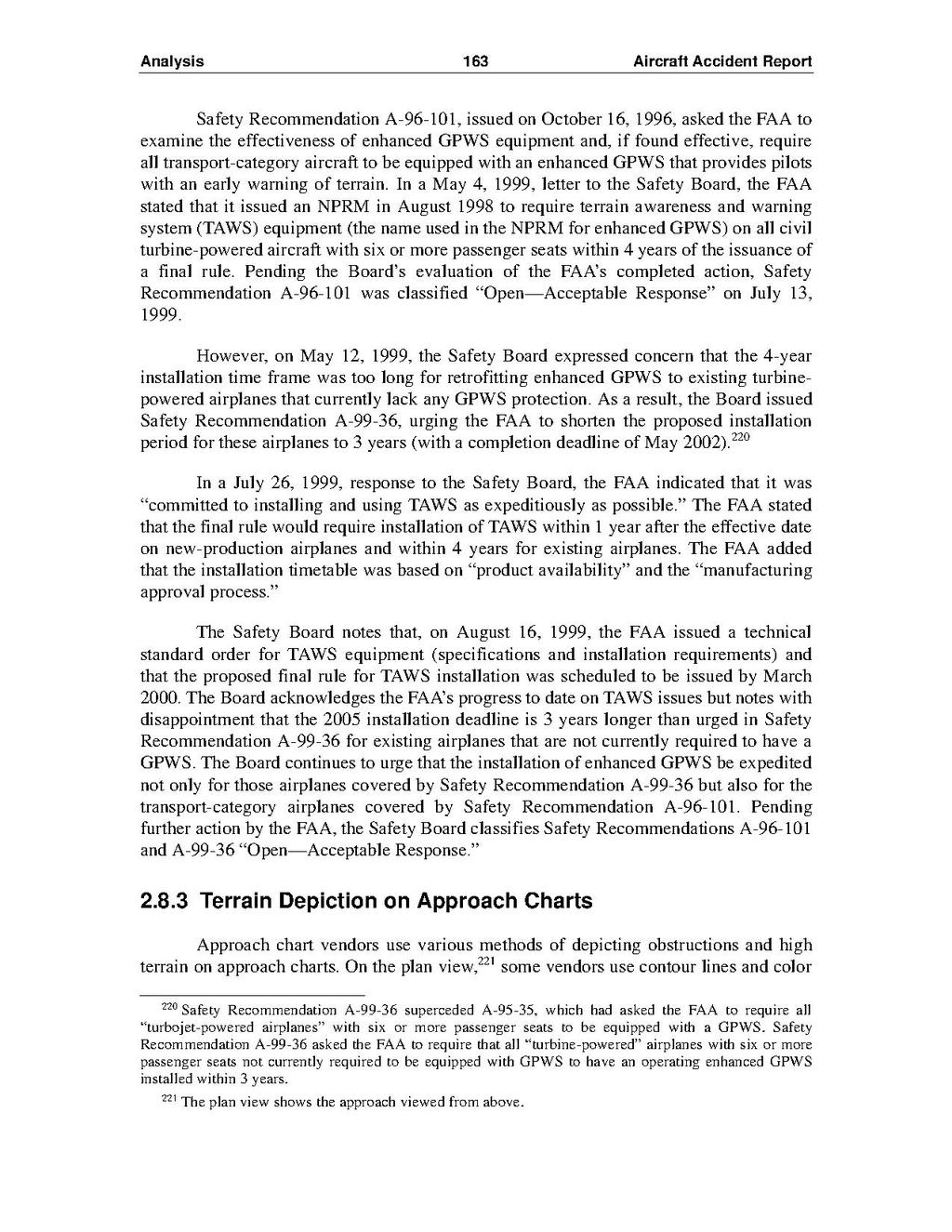Safety Recommendation A-96-101, issued on October 16, 1996, asked the FAA to examine the effectiveness of enhanced GPWS equipment and, if found effective, require all transport-category aircraft to be equipped with an enhanced GPWS that provides pilots with an early warning of terrain. In a May 4, 1999, letter to the Safety Board, the FAA stated that it issued an NPRM in August 1998 to require terrain awareness and warning system (TAWS) equipment (the name used in the NPRM for enhanced GPWS) on all civil turbine-powered aircraft with six or more passenger seats within 4 years of the issuance of a final rule. Pending the Board's evaluation of the FAA's completed action, Safety Recommendation A-96-101 was classified "Open--Acceptable Response" on July 13, 1999.
However, on May 12, 1999, the Safety Board expressed concern that the 4-year installation time frame was too long for retrofitting enhanced GPWS to existing turbinepowered airplanes that currently lack any GPWS protection. As a result, the Board issued Safety Recommendation A-99-36, urging the FAA to shorten the proposed installation period for these airplanes to 3 years (with a completion deadline of May 2002).[1]
In a July 26, 1999, response to the Safety Board, the FAA indicated that it was "committed to installing and using TAWS as expeditiously as possible." The FAA stated that the final rule would require installation of TAWS within 1 year after the effective date on new-production airplanes and within 4 years for existing airplanes. The FAA added that the installation timetable was based on "product availability" and the "manufacturing approval process."
The Safety Board notes that, on August 16, 1999, the FAA issued a technical standard order for TAWS equipment (specifications and installation requirements) and that the proposed final rule for TAWS installation was scheduled to be issued by March 2000. The Board acknowledges the FAA's progress to date on TAWS issues but notes with disappointment that the 2005 installation deadline is 3 years longer than urged in Safety Recommendation A-99-36 for existing airplanes that are not currently required to have a GPWS. The Board continues to urge that the installation of enhanced GPWS be expedited not only for those airplanes covered by Safety Recommendation A-99-36 but also for the transport-category airplanes covered by Safety Recommendation A-96-101. Pending further action by the FAA, the Safety Board classifies Safety Recommendations A-96-101 and A-99-36 "Open--Acceptable Response."
2.8.3 Terrain Depiction on Approach Charts
Approach chart vendors use various methods of depicting obstructions and high terrain on approach charts. On the plan view,[2] some vendors use contour lines and color
- ↑ 220 Safety Recommendation A-99-36 superceded A-95-35, which had asked the FAA to require all "turbojet-powered airplanes" with six or more passenger seats to be equipped with a GPWS. Safety Recommendation A-99-36 asked the FAA to require that all "turbine-powered" airplanes with six or more passenger seats not currently required to be equipped with GPWS to have an operating enhanced GPWS installed within 3 years.
- ↑ The plan view shows the approach viewed from above.
